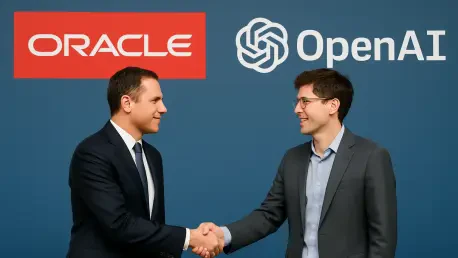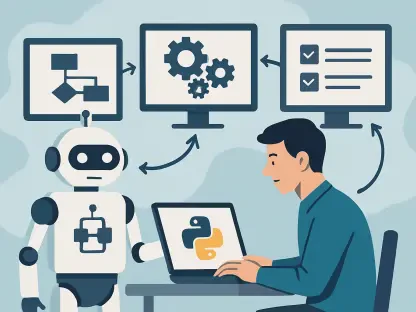In an era where artificial intelligence is rapidly becoming the cornerstone of technological progress, Oracle Corp. has struck a monumental $300 billion, five-year partnership with OpenAI, set to begin in 2027, marking a seismic shift in the AI infrastructure landscape. This deal not only positions Oracle as a formidable force in cloud computing but also underscores the critical importance of raw processing power in driving AI innovation. With OpenAI committing to an estimated $60 billion annually for computing resources starting in 2028, the scale of this alliance is unprecedented. Beyond the staggering financials, this partnership raises pivotal questions about the future of AI development, the evolving role of legacy tech giants, and the challenges of sustaining such ambitious endeavors. As the tech world watches, the implications of this collaboration promise to ripple across industries, potentially redefining competitive dynamics in cloud services and generative AI models like OpenAI’s Stargate initiative.
The Strategic Impact of the Oracle-OpenAI Partnership
Redefining Oracle’s Role in Tech
Oracle, long regarded as a stalwart in enterprise software, is undergoing a dramatic transformation through this landmark deal, positioning itself as a leader in cloud and AI infrastructure. Under the strategic vision of co-founder Larry Ellison, the company is aggressively pivoting to challenge hyperscalers like Amazon, Google, and Microsoft. This partnership with OpenAI serves as a powerful catalyst, enabling Oracle to leverage its investments in data centers and AI-optimized hardware. The deal’s financial impact is already evident, with Oracle’s future revenue commitments soaring to $317 billion, largely driven by AI-related contracts. This shift is not merely about numbers; it represents a rebranding of Oracle as a critical player in the AI era, shedding its legacy image for a future-focused identity that prioritizes cutting-edge technology and infrastructure scalability.
The implications of Oracle’s reinvention extend beyond its corporate strategy to influence the broader tech ecosystem. By aligning with OpenAI, a frontrunner in generative AI, Oracle gains credibility and visibility in a space dominated by newer, cloud-native giants. This move also signals to other legacy tech firms that adaptation to AI-driven markets is not just possible but essential for survival. Ellison’s foresight in prioritizing cloud growth—evidenced by a stock surge of over 40% in a single day, the largest since 1992—demonstrates a calculated risk that could inspire similar transformations across the industry. However, sustaining this momentum will require Oracle to navigate fierce competition and prove its infrastructure can match the reliability and innovation of established cloud leaders.
OpenAI’s Push for Independence
OpenAI’s decision to partner with Oracle reflects a deliberate strategy to diversify its cloud infrastructure and reduce dependence on Microsoft Azure, its primary provider to date. This shift is driven by a need for greater flexibility in securing the massive compute power required for next-generation AI models like Stargate. Amid reported tensions with Microsoft, a key backer, OpenAI’s move to broaden its partnerships highlights a pragmatic approach to mitigating risks associated with over-reliance on a single cloud provider. This diversification is not just about operational redundancy; it’s a statement of intent to maintain autonomy in a field where access to resources can dictate the pace of innovation and market positioning.
Furthermore, this strategic pivot underscores a growing trend among AI companies to seek multiple infrastructure partners as a way to fuel rapid growth and adaptability. For OpenAI, projected to reach profitability by 2029 despite current revenue estimates of $10 billion to $13 billion, securing varied compute resources is critical to sustaining its ambitious roadmap. The partnership with Oracle offers a pathway to scale projects that demand exponential processing power, ensuring that innovation isn’t bottlenecked by infrastructure limitations. Yet, this independence comes with complexities, as managing multiple cloud environments and aligning them with long-term goals will test OpenAI’s operational agility in an increasingly competitive AI landscape.
Challenges and Risks in the AI Infrastructure Race
Financial High Stakes
The financial dimensions of the Oracle-OpenAI partnership are as staggering as they are risky, with Oracle’s market valuation skyrocketing on the back of this deal while its high debt-to-equity ratio of 427% raises red flags about sustainability. Compared to Microsoft’s more conservative 32%, Oracle’s aggressive investment in AI infrastructure, outpacing cash flow, suggests a gamble that could either redefine its future or strain its resources. The company’s future revenue commitments of $317 billion signal investor confidence, but the pressure to deliver on these promises amid such leverage is immense. If the AI boom falters or execution stumbles, Oracle could face significant financial headwinds, making this a high-stakes bet on an unproven market trajectory.
For OpenAI, the financial burden is equally daunting, with projected annual payments of $60 billion to Oracle starting in 2028, alongside the need to potentially raise over $250 billion in funding. This comes at a time when investor enthusiasm for AI may be cooling, posing a challenge to sustaining cash flow if adoption rates don’t meet expectations. The scale of investment required for projects like Stargate could strain OpenAI’s finances, especially if profitability timelines stretch beyond current projections. Balancing innovation with fiscal responsibility will be critical, as any misstep in managing these massive commitments could jeopardize not just the partnership but OpenAI’s broader ambitions in the AI sector.
Energy and Operational Hurdles
One of the most pressing challenges of this partnership lies in the unprecedented energy demands of AI projects like Stargate, which includes a gigawatt-scale facility in Texas that could require up to 4.5 gigawatts of power—enough to energize several major cities. Such requirements highlight a critical bottleneck in AI infrastructure: sourcing sustainable energy to support these massive operations. Discussions around nuclear or renewable solutions are gaining traction, but the feasibility of implementing them at scale remains uncertain. This issue extends beyond Oracle and OpenAI, reflecting an industry-wide struggle to align technological advancement with environmental and logistical realities.
Operationally, building infrastructure to meet these demands presents another layer of complexity, particularly amid global energy constraints and supply chain disruptions. The physical rollout of data centers and AI-optimized hardware must keep pace with ambitious timelines, a task made harder by the sheer scale of the endeavor. For Oracle, the challenge is to ensure reliability and efficiency in delivery, while OpenAI must integrate these resources seamlessly into its development pipeline. Failure to address these hurdles could delay projects, erode trust, and invite scrutiny from stakeholders, making energy and operational execution pivotal to the partnership’s success.
Broader Implications for the AI Industry
The Compute Arms Race
The Oracle-OpenAI deal epitomizes the intensifying “compute arms race” in AI, where access to vast processing power has become as crucial as talent or algorithms in determining market dominance. Oracle’s aggressive expansion of data centers and specialized hardware positions it as a serious contender against cloud giants like Amazon, Google, and Microsoft, reshaping competitive dynamics. This partnership signals that compute capacity is no longer just a backend necessity but a strategic asset that can dictate the pace of AI breakthroughs. As companies vie for leadership, alliances like this one could set new benchmarks for what it takes to lead in innovation and scalability.
Moreover, the race for compute power is driving a fundamental shift in how tech companies allocate resources and prioritize investments. Oracle’s projected cloud revenue of $114 billion by 2029 reflects a broader trend of redirecting capital toward AI infrastructure, even at the expense of short-term financial stability. This focus on raw processing capability underscores a reality where the ability to train complex models faster and more efficiently can create insurmountable advantages. However, as more players enter this race, the risk of overinvestment and diminishing returns looms, challenging firms to balance ambition with pragmatic growth strategies.
Balancing Growth and Sustainability
The intersection of AI development and environmental concerns is becoming increasingly prominent, as the massive energy requirements of initiatives like Stargate raise questions about long-term sustainability. The tech industry faces mounting pressure to innovate not just in algorithms but in how power is sourced and consumed, with potential solutions like renewable energy grids or nuclear options still in early stages. This partnership highlights a critical tension: while AI promises transformative benefits, its ecological footprint could undermine public and regulatory support if not addressed. Oracle and OpenAI must navigate these concerns to maintain credibility and ensure their advancements don’t come at an unsustainable cost.
Looking back, the dialogue around balancing growth with sustainability gained urgency as the energy demands of AI projects became apparent through this deal. The industry took note of the need for systemic changes in infrastructure planning to accommodate such scale without compromising environmental goals. As a next step, stakeholders across the sector were encouraged to prioritize collaborative efforts in developing energy-efficient technologies and advocating for policies that support green computing. The legacy of this partnership ultimately rested on whether it could inspire a model for growth that harmonized technological progress with planetary stewardship, setting a precedent for future AI endeavors.









